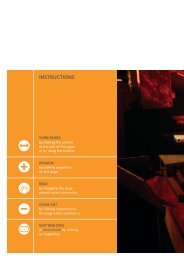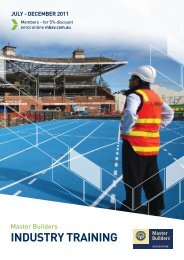Updates | technicalThe Use of Contracts inBuilding and ConstructionTypes of Contracts (Part 2)By Kim BlackberryFollowing on from Part 1 of the article published in the last edition of Master Builder we will look at the standardtypes of contracts available, what a good contract should have in it, a checklist for you to use when examiningany contract and a flowchart of what contract to use when.With the development of MBA Services MBT can now work with you to develop a suite of contracts and guidesspecifically tailored for you business and badged accordingly. If you wish to know more about these servicesplease contact your local MBA office.MBT offers the following standardcontracts:• ABIC• Simple works Housing (Principal versionalso)• Simple works Commercial (Principalversion also)• Major works Housing (Principal versionalso)• Major works Commercial (Principal versionalso)• Early works Housing• Early works Commercial• Subcontract Agreement• MBT• Domestic Building Contract (FormerlyBO4)• Cost Plus• Minor Works• PB1• Variation• Offer/Agreement• Quotation/Agreement• Specification• Deacon2 Lump Sum• Deacon2 Subcontract• CM2• Multi/Single use Subcontractor• TC 2007 Trade Contract• IC 2007 Agreement• PTC 2009 Period Table Contract• PTC 2009 Work Orders and Quotation Pads• SMOM and Technical Q&A• Australian Standards• AS 2124 General Conditions• AS2124N – Notes• AS 2545 Subcontractors• AS4000 General Conditions• AS4901 SubcontractorsAs can be seen the range of contracts is extensive and there aremany other contracts published by various companies, associationsand Government agencies.The first thing to understand is what needs to be in a contract. Thecontract is the written intention of the parties clearly stating thebargain negotiated.A contract can be broken down into the following parts:• Scope of work – What is to be delivered• Schedule – Time for performance• Terms of Payment – what and how you are to be paid• Assurances of Performance – What each party is to do.• Insurance – to protect the parties from loss• Indemnity – clarification of liabilities• Changes – how the contract many be varied• Disputes – how disputes are to be resolved• Warranty – Quality of work• Termination and Suspension – Ending the contract• Assignment – power to assign contract• Venue and Applicable law – jurisdiction the contract falls intoAll contracts you deal with should contain clauses dealing with theabove items. If a contract does not contain all of the above seekfurther advice before signing.Contracts may be classified in many ways but for simplicity sakethe easiest starting point is major and minor works. Major workscontracts are for large expensive projects generally over $100,000. Aminor work is generally below that amount.Secondly, is the project being supervised by an architect? If so thenthe contract will need to have provisions detailing this. This is whereyou would likely use an ABIC contract. If not using a supervisingarchitect then you can use a MBA standard contract.Is the work for a project you have control of where you want to usesubcontractors? If so then you will use either a MBA standard singleor multiuse subcontractor’s contract.Thirdly is the work prior to a client committing to a build thenyou would look at using a pre-contract or preliminary agreement.Following is a table outlining the use of certain ABIC contracts.14 | master builders tasmania
Updates | technicalABIC Contract DescriptionsAbic Mw-2008 Major Works ContractStandard contract for non-housing work. (Not to be used in Queensland)In WA this contract is suitable for housing projects over $500,000.Abic Mw-2008 Major Works Contract – HousingState and territory specific contract for housing work, with appropriateconditions integrated into the contract to addxress legal requirements ofstate and territory housing legislation. (Not to be used in Queensland or inWA for projects over $500,000.)ABIC MW-1 2003 Major Works Contract(Queensland only)ABIC MW-1 2003 is suitable for major or complex building projectswhere an architect administers the contract. When purchased for usein Queensland, unique special conditions for commercial and industrialprojects are included with the contract. MW-1 (2003) is also suitable forhousing projects in Queensland when used with the special conditionsincluded in the pack.Abic Sw-2008 Simple Works ContractStandard contract for non-housing work. (Not to be used in Queensland)In WA this contract is suitable for housing projects over $500,000.Abic Sw-2008 Simple Works Contract - HousingState and territory specific contract for housing work, with appropriateconditions integrated into the contract to address legal requirements ofstate and territory housing legislation. (Not to be used in Queensland or inWA for projects over $500,000.)ABIC SW-1 2002 Simple Works Contract(Queensland only)ABIC SW-1 2002 is suitable for smaller/simpler projects where anarchitect administers the contract. When purchased for use inQueensland unique special conditions for commercial and industrialprojects are included with the contract. SW-1 2002 also complies withhousing legislation when used with special conditions included in thepack for the relevant state or territory.ABIC EW-1 2003 Early Works ContractIt will give you an idea of each type of contracts function which willbe applicable generally to that style of contract. You will notice thatsome of the contracts are applicable only to a specific state. As eachstate’s laws vary it is important to ensure the contracts you use areapplicable for your state. One way to ensure you are using the rightcontract for your state is to use your local MBA standard contracts.If you are building a residential building with a fixed price you woulduse the MBA BO4 Owner/Builder. If it is not a fixed price you woulduse the MBA Cost Plus Contract.If you are doing a commercial build where you are the principal andunsupervised you would use Major Works Contract. Often you willfind that the owner has a specific contract drafted by their lawyer.If the work is to be supervised then you would use an ABICcontract. If you would like an electronic copy of the flowchart thatcompliments the ABIC contract please send a request by email tokim@MBTas.org.auNon - ABICContract DescriptionsThis contract is suitable for early works (demolition and/or groundworksincluding temporary works) where an architect administers the contract.When purchased for use in Queensland, unique special conditions forcommercial and industrial projects are included with the contract. EW-12003 is also suitable for housing projects using the relevant specialconditions included in the pack for the relevant state or territory, otherthan Queensland. (In Queensland, only single dwellings and duplexesare ‘housing’ in this sense, for which there is seldom a need for this formof contract.)ABIC BW-1 2002 Basic Works ContractABIC BW-1 2002 is suitable for small commercial projects or single tradeactivities where an architect administers the contract in all states andterritories except Queensland, where there are compulsory contractconditions it does not comply with. It is also suitable for residentialbuilding throughout Australia, as state and territory special conditionsare ‘embedded’ in the document as a Schedule. The tender form andcontract schedules are provided with the contract, and become part ofthe contract on signing by both the contractor and owner.FF/C Cost plus ContractFF/C is a contract administered by an architect intended for commercialbuilding works including alterations, where payments to the contractorare on the basis of the actual cost of the work, plus a fee. The fee maybe a lump sum or a percentage of the cost of the work. FF/C does notallow for GST, so must be used with caution to deal with GST exclusiveamounts only, with GST added according to law when payments are madeto the contractor. FF/C may be suitable for housing projects, subject tolegislative provisions in the relevant state or territory. For example, it maynot be used without amendment where arbitration is disallowed - namelyVictoria, New South Wales and Queensland. For these reasons, legal adviceis recommended and special conditions may be required.Door HarDware DistributorsanD locksmitHingMBT Trade Supplier12 Goodman Crt, Launceston21 Brisbane Street, HobartFor suPPlY & Quotations statewiDe• COMMERCIAL AND DOMESTICDOOR HARDWARE• WASH ROOM EQUIPMENT• GRAB RAILS• SLIDING DOOR TRACKSCENTOR + COWDROY• MADINOZ DOOR FURNITURE• ACCESS CONTROL LOCKS• RAVEN DOOR SEALSContact: Launceston Phone: 6324 4900Fax: 6324 4901Hobart Phone: 6235 9000Fax: 6231 9927master builders tasmania | 15Access Hardware AD.indd 17/02/11 3:39 PM

















